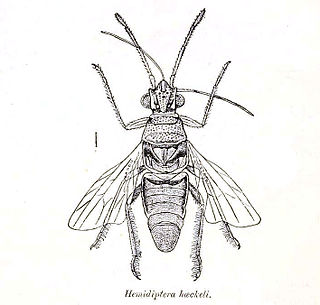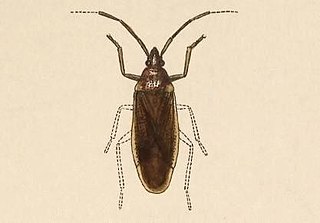
The Lygaeoidea are a sizeable superfamily of true bugs, containing seed bugs and allies, in the order Hemiptera. There are about 16 families and more than 4,600 described species in Lygaeoidea, found worldwide. Most feed on seeds or sap, but a few are predators.

The Lygaeidae are a family in the Hemiptera, with more than 110 genera in four subfamilies. The family is commonly referred to as seed bugs, and less commonly, milkweed bugs, or ground bugs. However, while many of the species feed on seeds, some feed on sap (mucivory) or seed pods, others are omnivores and a few, such as the wekiu bug, are carnivores that feed exclusively on insects. Insects in this family are distributed across the world. The family was vastly larger, but numerous former subfamilies have been removed and given independent family status, including the Artheneidae, Blissidae, Cryptorhamphidae, Cymidae, Geocoridae, Heterogastridae, Ninidae, Oxycarenidae and Rhyparochromidae, which together constituted well over half of the former family.

Nysius is a genus of false chinch bugs in the family Lygaeidae. At least 100 described species are placed in Nysius.

Heterogastridae is a family of lygaeoid bugs consisting of about 20 genera and more than 100 species.

The Blissidae are a family in the Hemiptera, comprising nearly 50 genera and 400 species. The group has often been treated as a subfamily of the Lygaeidae but was resurrected as a full family by Thomas Henry (1997).

Orsillinae is a subfamily of seed bugs in the family Lygaeidae. There are at least 110 described species in Orsillinae; the type genus is Orsillus.
Lygaeospilus is a genus of seed bugs in the family Lygaeidae. There are at least four described species in Lygaeospilus.

Oxycarenidae is a family of true bugs in the order Hemiptera. There are more than 20 genera and 140 described species in Oxycarenidae.

Lethaeini is a tribe of dirt-colored seed bugs in the family Rhyparochromidae. There are more than 40 genera and 180 described species in Lethaeini.

Geocoridae is a family of big-eyed bugs in the order Hemiptera. There are more than 290 described species in Geocoridae.

Metacanthinae is a subfamily of stilt bugs in the family Berytidae. There are about 12 genera and 80 described species in Metacanthinae.

Artheneidae is a family of true bugs in the order Hemiptera. It was formerly included in Lygaeidae. There are about 7 genera and at least 20 described species in Artheneidae.

Gampsocorinae is a subfamily of stilt bugs in the family Berytidae. There are about 60 described species in Gampsocorinae.

Pachygronthidae is a family of true bugs in the order Hemiptera. There are about 14 genera and more than 80 described species in Pachygronthidae.

Melanopleurus is a genus of seed bugs in the family Lygaeidae. There are more than 20 described species in the genus Melanopleurus.

Ninidae is a family of true bugs in the order Hemiptera. There are about 5 genera and 14 described species in Ninidae.
Colobathristidae is a family of true bugs in the order Hemiptera. There are more than 20 genera and 90 described species in Colobathristidae.

Malcidae is a family of true bugs in the order Hemiptera. There are at least 4 genera and more than 40 described species in Malcidae.

Crompus is a genus of seed bugs in the family Lygaeidae. Crompus are terrestrial insects in the Ischnorhynchinae subfamily of seed bugs that are endemic to Australia. There are three described species in Crompus.


















